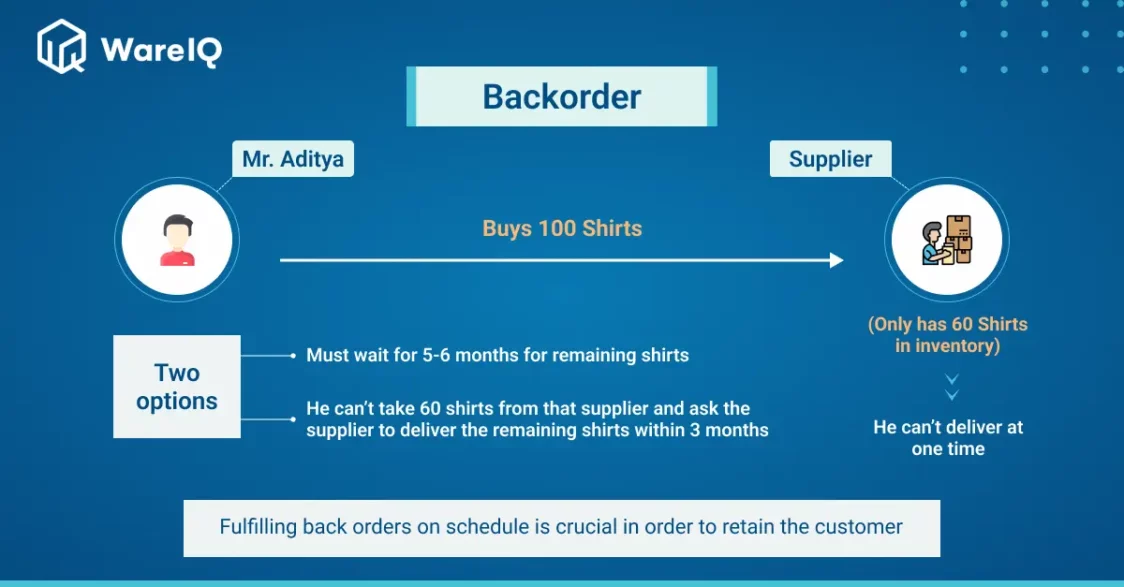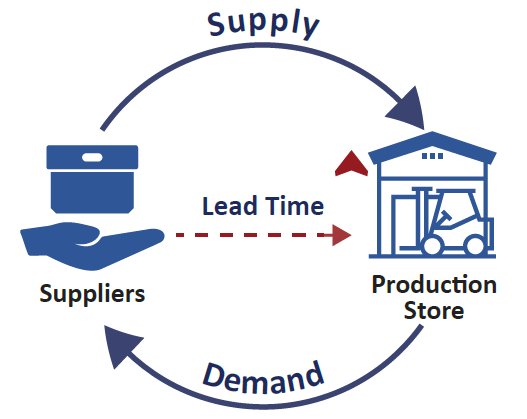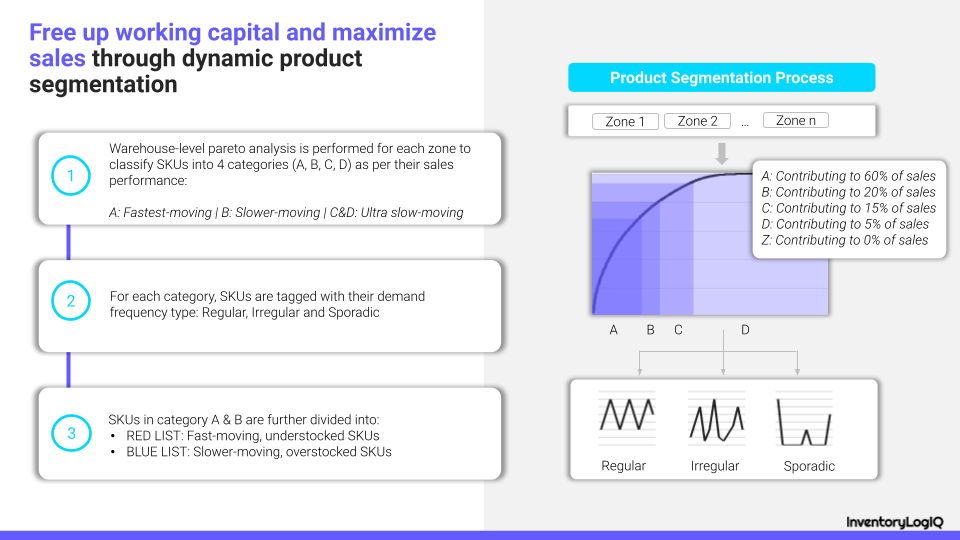What Are Backorders In Supply Chain? Why Are Backorders Generated In The Supply Chain and How To Cut Back On or Avoid Backorders?
Global retail eCommerce sales were estimated at 5.2 trillion dollars in 2021. By 2026, this amount is expected to have increased by 56%, totalling roughly 8.1 trillion dollars.
There has been increased interest in eCommerce backorders to protect revenue in light of the supply chain problems we have encountered on a global scale over the past few years. Business owners have been forced to decide between displaying their products as completely unavailable or as backordered for the time being because product availability still needs to be determined for numerous online stores and big marketplaces.
Backorders are orders placed for items not currently in stock in eCommerce. A product is on backorder if it isn’t in stock but is still accessible to customers for purchase. Customers who backordered items will have to wait longer to obtain them.
The length of the customer’s delay depends on where the supply chain shortfall occurs. Suppose the manufacturer is to blame for the supply shortfall. In that case, the consumer may have to wait an extended period, which would be detrimental to their satisfaction. Backorders in supply chain can be avoided, and customer loyalty can be increased with effective inventory management and communication throughout your supply chain.
- What Are Backorders in the Supply Chain?
- What Differentiates a Backorder from an Out-of-Stock Item?
- How Does Backorder Affect The Supply Chain In eCommerce?
- Why Are Backorders Generated In The Supply Chain?
- How To Cut Back On or Avoid Backorders in 2023?
- Conclusion
- Get Assistance From WareIQ's AI-Based Inventory Optimization Tool – InventoryLogIQ and Bid Farewell To Backorders
- Backorders in Inventory Management: FAQs
What Are Backorders in the Supply Chain?
Backorders in the supply chain are requests that sellers guarantee to fulfill despite not having the requested item in stock. Your consumer agrees to hold off until the shipping date specified in the guarantee. As an illustration, suppose you are selling a product and have received orders from three clients. They want four products each, but you only have seven in stock. In this circumstance, you must complete more than one order while letting the other three go unfulfilled and losing them to the competitors. A better solution would be to send one item to each of them and tell them that the rest of their order will be fulfilled soon. Back-ordering is a process that is widely used in the eCommerce sector.

What Differentiates a Backorder from an Out-of-Stock Item?
The topic of “what’s the difference between something being on backorder vs it being out of stock” is one that many novice eCommerce business owners (and their consumers) face.
Although there is a clear difference between the two expressions, they both refer to an inventory deficit of some sort. Backordered items only experience a brief shortage because the manufacturer or supplier produces or brings extra inventory. A commodity out of stock might never be produced, meaning it might never be sold directly to the public again.
Backorders in supply chain essentially makes the item temporarily unavailable, but an out-of-stock item can be lost forever (barring hypothetical returns, refurbishments, or future reissues of that item)
How Does Backorder Affect The Supply Chain In eCommerce?
Backorders might cause more damage to a supply chain that is longer than usual. For example, imagine an online retailer with a well-liked product currently on backorder. When the retailer orders from their supplier again, the latter must fulfil the steady demand and the additional backorder stock.
The distributor or manufacturer bears the additional burden if the supplier has yet to have the product available to fulfill the reorder. As more and more stock is bought and produced to satisfy the need, the additional demand from those backorders is amplified at each checkpoint in the supply chain, from supplier to distributor to manufacturer. It’s common to refer to this extra stock as buffer stock.
The bullwhip effect, a severe overcorrection in the supply chain that can emerge from unanticipated demand variations, can result in excess inventory and increased costs.
Why Are Backorders Generated In The Supply Chain?
Backordering puts pressure on the supply chain and puts its responsiveness to the test for any firm. It could happen due to a need for more control over the factors governing the production process. As a result, the issue could occur at any point in the supply/production cycle. However, for your convenience, we’ve included the top three explanations below:
Unprecedented Demand Growth
Despite advanced sales forecasting, it is frequently challenging to predict spikes in demand. Online retailers rely on predetermined techniques to best capitalize on them because they are unavoidable. However, your marketing may also be a likely cause of demand spikes. Maintaining appropriate inventory levels is equally important to keep your marketing initiatives in sync with the supply chain. In addition, endorsements like affiliate marketing or influencer marketing might lead to unexpected demands for your items.
Inappropriate Vendor Management
Backordering can occur for various reasons, such as inadequate vendor management systems or insufficient sourcing options. For instance, if your vendor doesn’t deliver the goods on time, you’ll have to deal with backorders in supply chain chaotically even though demand patterns have stayed the same. In addition, due to the goods being sold by your rivals, your clients may also be looking for other suppliers.
Improper Inventory Management
Errors are sure to occur if a company doesn’t have the proper stock levels or cannot track its inventory movement. Each online store has more SKUs than ever, and trends are shifting more quickly than before. Backorders in inventory management must be used to maximize eCommerce operations in such situations. It ensures you can see your inventory clearly and won’t accidentally commit any items only to discover differences afterward.
Production Constraints
Your supply chain may have problems, which could lead to a backorder. Your supply chain may need to prepare for an unexpected demand increase for its raw materials. This might make it challenging to supply vendors, which would reduce output. Supply chain issues, however, frequently arise from improper communication between the various parts.
If someone further down the chain makes a mistake, the ripple effect will reach you and get stronger. For example, consider a scenario where you, the retailer, asked your wholesaler for a specific inventory quantity. As a result, the wholesaler may order less than you recommended if they are especially cautious about being safe.
From the distributors to the manufacturers, there will be a continual “ripple effect.” As a result, you’ll ultimately receive a small portion of what you ordered when you place your order. Lower stock levels and possible backorders are the results of this.
Human Error
Even if the item is in stock, a staff member may enter an order as a backorder. Even worse, a shop could approve a backorder for an item even though it’s not in stock. This could result from a mistake or a delay in inventory updates.
Inadequate Safety Stock
Most businesses have insurance policies to prevent out-of-stock problems, even if the supply chain malfunctions. An excess stock used as a backup in emergencies is a safety stock. Safety stocks help you stay afloat in the event of rising demand or low supply. Backordered goods may occur if you pay more attention to the quantity of safety stock you need.
How To Cut Back On or Avoid Backorders in 2023?

Backordering can occur accidentally or as a result of poor preparation. For example, suppose your business is experiencing backorders in supply chain issues that negatively hurt your sales and inventory turnover ratio. In that case, there are a few strategies to prevent the problem.
Demand Forecasting
Utilizing previous data and trends, demand forecasting projects future sales and demand. With enough information on sales and inventory trends, a company can identify patterns that will help them order goods at the right amounts. Handling backorders in inventory management with help of software makes this simple. Additionally, consider how many days of inventory you anticipate having and whether your supplier has a minimum order amount (minimum order quantity)
Lead Time Management

Your supplier’s lead time in supply chain is the period it takes for you to receive a product from them. This period may be influenced by several variables, including how long it takes your supplier to obtain the raw materials, how long it takes them to produce the product, and how long it takes to examine the finished good.
Find strategies to shorten the lead time by coordinating with your suppliers. Start discussions about developing improved turnaround times if you’ve discovered that they frequently deliver their products later than anticipated. There are more effective ways for both parties to work together and meet needs.
Appropriate Safety Stock
Stock intentionally purchased as a reserve in case demand spikes is known as a safety stock. When the regular inventory runs out, access to this stock from storage is made. Doing this guarantees that your consumers will never have to wait to buy the goods you have for sale. A fantastic strategy to guarantee that stock levels are consistently tracked has a dedicated order management specialist who can perform a regular inventory audit.
Diversify Your Suppliers
To maintain high inventory levels, having several manufacturers and suppliers on your team can be helpful. Since you’ll have an alternative to working with, this helps to ensure that supply chain problems at one manufacturer don’t leave you stranded. Additionally, having access to two inventory sources allows for quicker fulfilment of backorders when demand is very high.
Engage With Your Customer
Be sure to inform your customers immediately if a problem results in a popular product going on backorder in the supply chain. People are less likely to experience surprises from delays if there is an alert posted on the product’s page along with an estimated return date. Additionally, it would be beneficial to mention the cause of the backorder to assist in managing client expectations (manufacturer supply issue, unexpected high demand, etc.). Finally, customers may choose to be notified when a backordered item becomes available again, allowing them to purchase it. So, it is important to provide a good customer service experience.
Collaborate With a 3PL
A third-party logistics provider (3PL) can enhance the backorder customer experience by speeding up the fulfilment of backorders. They can offer fulfilment services to keep your backordered goods moving smoothly through the supply chain. A backorder product’s delivery is accelerated by the warehouse management team of a 3PL fulfilment centre when it arrives there. Cross-docking is moving a product directly from the warehouse to the shipping dock instead of other products going to the shelves like other products. Before making unavailable items available, consider looking for a 3PL to handle and expedite backorders.
Conclusion
Backordering may be seen adversely by management, but it shows how valuable your brand is. Furthermore, it communicates your market dominance and the idea that customers would rather wait for your product than purchase a similar one from a rival. As a result, every eCommerce business must carefully balance the excitement of their clients to wait for them with their frustration at having to wait too long.
You may handle such scenarios and effectively satisfy market expectations with appropriate tools and best practices.
Get Assistance From WareIQ’s AI-Based Inventory Optimization Tool – InventoryLogIQ and Bid Farewell To Backorders
With the help of WareIQ’s B2B fulfillment services and Inventory LogIQ, an inventory optimization tool, you can track stock levels in real-time, set reorder points and safety stock, and analyze historical data to learn more about your top-selling SKUs, inventory velocity, ideal distribution, and other topics while also expediting orders to provide the best possible customer service. Bottom line: Should you encounter backordered products, we’ll work with you to fulfill them as soon as your inventory arrives.

With WareIQ, you can accept backorders, create purchase orders for them, and get real-time visibility.
Recognize Products That Are Appropriate For Backordering
Retailers now have the much-needed insight they require regarding each supply chain step thanks to WareIQ’s inventory management and fulfilment platform. However, WareIQ also helps with inventory tracking, minimum order amounts, and production lead times across every supplier or distributor, in addition to integrating your eCommerce operations within one complete dashboard. As a result, you will have better insight to decide which products are suited for backorder and which should be maintained in stock for your company.
Automation Can Enhance Backordering and Other Inventory Operations
Numerous automation is built into WareIQ’s sophisticated and cutting-edge inventory management system to boost company intelligence, boost productivity, and reduce operating expenses. As a result, backorder efficiency in supply chain management can easily increase by automating your inventory procedures. For instance, to guarantee that backorders go as smoothly as possible, WareIQ’s comprehensive automation provide notifications on your inventory levels, watch your order status, and source real-time inventory data.
Determine The Root Of The Problem To Promote Brand Growth
There is no denying that every eCommerce business aspires to expand and develop its brand. Fortunately, WareIQ’s inventory management programme includes all you require to grow your company for a very long time. With WareIQ’s forecasting tools, you may get pertinent information to inform your choices and identify the root of backorders across your warehouses and distribution networks. Additionally, merchants may monitor savings to serve their consumers better, resulting in longer-term customer loyalty and retention.
- Pan India Fulfillment & Darkstore Network: Plug-and-play fulfillment infrastructure with no minimums, which is compliant with Amazon Seller Flex, Flipkart Assured, Myntra and other marketplaces
- Inventory & Network Planning Excellence: Best-in-class AI models for sales forecasting, product segmentation, and inventory management to reduce inventory by 40% and increase revenue by 10%.
- Vertically Integrated Fulfillment Tech Stack: Our Fulfillment Tech Solution supports integrations with 20+ top marketplaces & D2C platforms, and prominent national, regional and hyperlocal couriers, enhancing reach by covering deliveries for 27,000+ pin codes
- Supply Chain Productivity Applications: Integrate a host of supply chain productivity apps with a single-click to your existing CRMs, ERPs & accounting software to manage your logistics workflows from one command center. Use Apps like RTO Shield to get 100% RTO protection, Branded Tracking to turn your order tracking page into a profitable marketing channel, and many more.
Trusted by 300+ top Indian brands, we are helping them accelerate online sales and expedite their growth through a synergistic combination of advanced technology, robust fulfillment infrastructure & seller enablement services!WareIQ is backed by leading global investors including Y Combinator, Funders Club, Flexport, Pioneer Fund, Soma Capital, and Emles Venture Partner.










